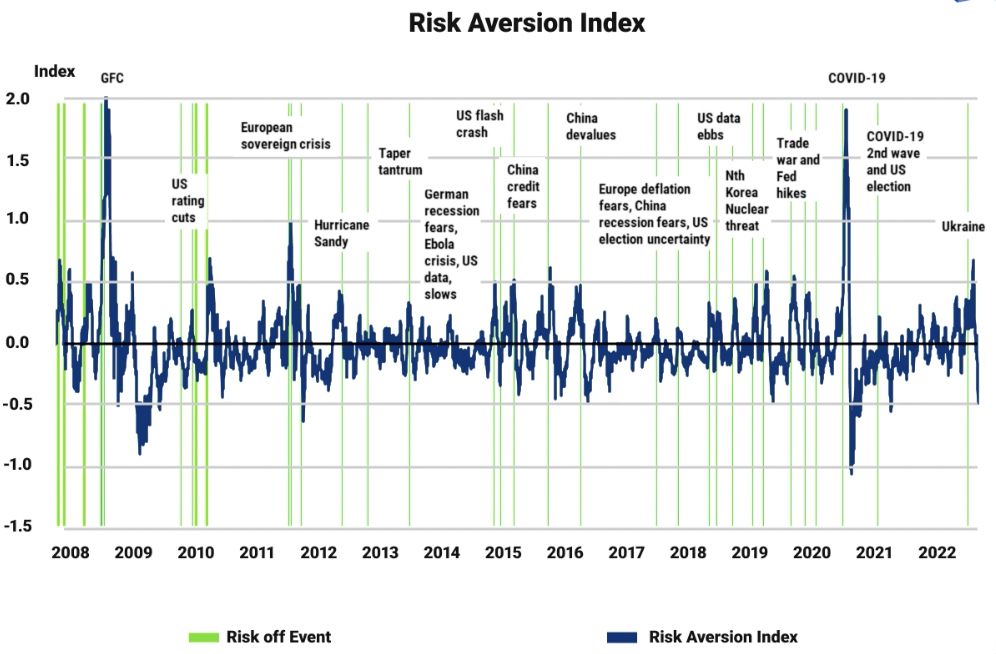Will the Ukraine risk reversal trade last?
Australian equities were a near-total anomaly in global markets last month, thanks to ongoing demand for our commodities. Global equities sank in the three months to March and bonds didn't perform much better either even in the face of rising real and nominal yields.
Within the Australian equity universe, being long energy and short technology was the place to be. Outside of the listed market, cash and floating-rate notes performed the best.
Was an equity rebound inevitable?
The biggest development during the quarter was the Russian invasion of Ukraine. Our central point is that even in a period of extreme uncertainty, markets will look for a ‘de-escalation’ scenario and we would see a short risk reversal.
A lot of this has played out mostly to the script.

This recovery in equity markets may seem surprising but this is typically the case amid geopolitical shocks. Risk reversals don’t require that things go back to where they were prior to the event shock, merely that something has occurred that suggests the probabilities of worst-case scenarios have declined.
Outlook for the June quarter
Global growth slowdown
Global growth was already slowing prior to the Ukraine conflict but the war has changed that. The process is likely to materialise much more in coming months and policymakers will scramble to adjust.
Sharply higher raw material and energy input costs have coalesced with tight labour markets to provide a genuine threat to profit margins. A sharp drop in US new orders relative to inventories suggests a sharper deceleration is coming.
Interestingly, the response by Governors at the Federal Reserve has been to ignore it. Instead, they appear to be so shocked by their collective inability to foresee the inflation spike that they have spent much of the past month openly campaigning to not only lift rates in larger increments of 50 basis points but to QT faster than the last time it was attempted in 2017.
It's hard to imagine that in that backdrop that global economic growth expectations won’t fall well short of current consensus expectations. Financial markets will remain attuned to global developments.
Higher inflation is a practical guarantee
Higher inflation is a fait accompli for 2022. It’s simply impossible for policymakers to ignore recent commodity price, supply chains, and labour market trends.
We have been warning about the rise in long run inflation expectations since early 2021 but it’s clear the rise in price pressures has gone merely beyond just monetary policy considerations.
This is now the central political and social item of the time.
In many ways, we quickly moved from a ‘policy of least regret’ for central bankers to a ‘policy of full regret and fear’.
Fear of the reputation and career risk of having missed the biggest inflation spike in 40 years and the fear that if they don’t slam the breaks on economic growth, they risk having to implement an even higher terminal rate later on.
The reality is higher inflation will persist for longer until central banks destroy enough demand to return underlying inflation towards their targeted levels.
Is it time to buy government bonds?
We now find ourselves in a place where interest rate markets are too richly priced for what will ultimately be delivered over the remainder of the year.
I think it's highly unlikely that the RBA will be hiking interest rates anything like eight times in 2022. I imagine most fixed income managers will await the roll down in pricing to reflect something more realistic like three to four hikes.
We are very mindful that the end of QE and the commencement of QT suggests that bonds may well continue to sell off.
However, the release of one million barrels per day from the US Strategic Reserve is a material event. This is multiples of any prior release, and it has the capacity to materially alter the trajectory of oil prices and in turn, inflation.
Secondly, it's notable that no one wants to be seen as being long bonds. Positioning data suggest speculative positions are amongst the lowest on record.
Finally, real bond yields will only really rise when inflation expectations peak and the Fed actually hikes short term rates several times. Both of these factors are in the frame for the June quarter.
For me, that means it’s time to neutralise our long held under weight in government bonds. For the first time in a long time, the risks are looking more evenly balanced for the outlook for bonds.
Never miss an insight
Stay up to date with all my latest macroeconomic insights by hitting the follow button below and you'll be notified every time I post a wire.

